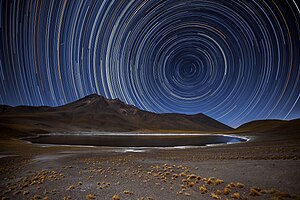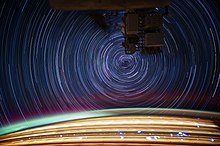Star trail

A star trail is a type of photograph that utilizes long-exposure times to capture the apparent motion of stars in the night sky due to the rotation of the Earth. A star trail photograph shows individual stars as streaks across the image, with longer exposures resulting in longer streaks. Typical exposure times for a star trail range from 15 minutes to several hours, requiring a 'bulb' setting on the camera to open the shutter for a longer period than is normal.
Star trails have been used by professional astronomers to measure the quality of observing locations for major telescopes.
Capturing star trail images

Star trail photographs are captured by placing a camera on a tripod, pointing the lens toward the sky, and allowing the shutter to stay open for a long period of time.[2] Star trails are considered relatively easy for amateur astrophotographers to create.[3] Photographers generally make these images by using a SLR camera with its lens focus set to infinity. A cable release allows the photographer to hold the shutter open for the desired amount of time. Typical exposure times begin at 15 minutes and can be many hours long, depending on the desired length of the star trail streaks on the image.[4] Even though star trail pictures are created under low-light conditions, the long exposure times allow for fast films, such as ISO 200 and ISO 400, to be used.[3] Wide-apertures, such as f/5.6 and f/4, are recommended for star trails.[2][5]
Because exposure times for star trail photographs can be several hours long, camera batteries can be easily depleted. Mechanical cameras that do not require a battery to open and close the shutter have an advantage over more modern film and digital cameras which utilize battery power. On these cameras, the Bulb, or B, exposure setting is used to keep the shutter open.[6] Another problem that digital cameras encounter is an increase in detector noise with increasing exposure time.[2]
American astronaut Don Pettit recorded star trails with a digital camera from the International Space Station in earth orbit between April and June, 2012. Pettit described his technique as follows: "My star trail images are made by taking a time exposure of about 10 to 15 minutes. However, with modern digital cameras, 30 seconds is about the longest exposure possible, due to electronic detector noise effectively snowing out the image. To achieve the longer exposures I do what many amateur astronomers do. I take multiple 30-second exposures, then 'stack' them using imaging software, thus producing the longer exposure."[7]
Rotation of the Earth
Star trail photographs are possible because of the rotation of the Earth on its axis. The apparent motion of the stars is recorded as streaks on the film or detector.[2] For observers in the northern hemisphere, aiming the camera towards the north creates an image with concentric circular streaks centered on the north celestial pole (very close to Polaris).[3] For observers located in the southern hemisphere, this same effect is achieved by aiming the camera south. In this case, the streaks are centered on the south celestial pole. Aiming the camera towards the east or west creates straight-line streaks that are angled with respect to the horizon. The size of the angle depends on the photographer's latitude.[2]
Astronomical site testing
Star trail photographs can be used by astronomers to determine the quality of a location for telescope observations. Star trail observations of Polaris have been used to measure the quality of seeing in the atmosphere, and the vibrations in telescope mounting systems.[8] The first recorded suggestion of this technique is from E.S. Skinner's 1931 book A Manual of Celestial Photography. [9]
Gallery
-
Star trails photographed by facing northwest.
-
Star trails over the ESO 3.6 m Telescope.[10]
-
A star trail photograph showing the apparent motion of stars around the north celestial pole; Polaris is the bright star near the pole, just above the jet trail.
-
The constellation of Cassiopeia over a thunderstorm.[11]
References
- ^ "All In A Spin". www.eso.org. Retrieved 1 August 2016.
- ^ a b c d e Malin, David (2007). "Night-Time and Twilight Photography". In Michael R. Peres (ed.). Focal Encyclopedia of Photography: Digital Imaging, Theory and Applications, History, and Science (4th ed.). Amsterdam: Elsevier. pp. 577–580.
{{cite encyclopedia}}:|access-date=requires|url=(help) - ^ a b c Landolfi, Larry (February 1996). "Come-as-you-are Astrophotography". Astronomy. 24 (2): 74–79. Bibcode:1996Ast....24...74K.
- ^ Burian, Peter K.; Caputo, Robert (1999). "A world of subjects: evening and night". In Kevin Mulroy (ed.). National Geographic photographic field guide: secrets to making great pictures (2nd ed.). Washington, D.C.: National Geographic. p. 276. ISBN 079225676X.
- ^ Manning, Jack (1981-04-05). "Shooting pictures that the eye cannot see". The New York Times. p. ARTS 38.
- ^ Frost, Lee (2000). "The sky at night". The Complete Guide to Night & Low-Light Photography. New York, New York: Amphoto Books. pp. 156–157. ISBN 0817450416.
- ^ NASA Johnson Space Center (May–June 2012). "ISS Star Trails". NASA JSC Photo Sets on Flickr.com.
- ^ Harlan, E.A.; Merle F. Walker (August 1965). "A Star-Trail Telescope for Astronomical Site-Testing". Publications of the Astronomical Society of the Pacific. 77 (457): 246–252. Bibcode:1965PASP...77..246H. doi:10.1086/128210.
- ^ King, Edward Skinner (1931). A Manual of Celestial Photography. Boston, Massachusetts: Eastern Science Supply Co. p. 37.
- ^ "Venus Transit Seen Reflected from the Moon". ESO Announcement. Retrieved 14 December 2012.
- ^ "The constellation of Cassiopeia over a thunderstorm". www.eso.org. European Southern Observatory. Retrieved 21 March 2015.


![Star trails over the ESO 3.6 m Telescope.[10]](http://upload.wikimedia.org/wikipedia/commons/thumb/f/f8/Star_trails_over_the_ESO_3.6-metre_telescope.jpg/120px-Star_trails_over_the_ESO_3.6-metre_telescope.jpg)

![The constellation of Cassiopeia over a thunderstorm.[11]](http://upload.wikimedia.org/wikipedia/commons/thumb/9/9e/The_constellation_of_Cassiopeia_over_a_thunderstorm.jpg/120px-The_constellation_of_Cassiopeia_over_a_thunderstorm.jpg)